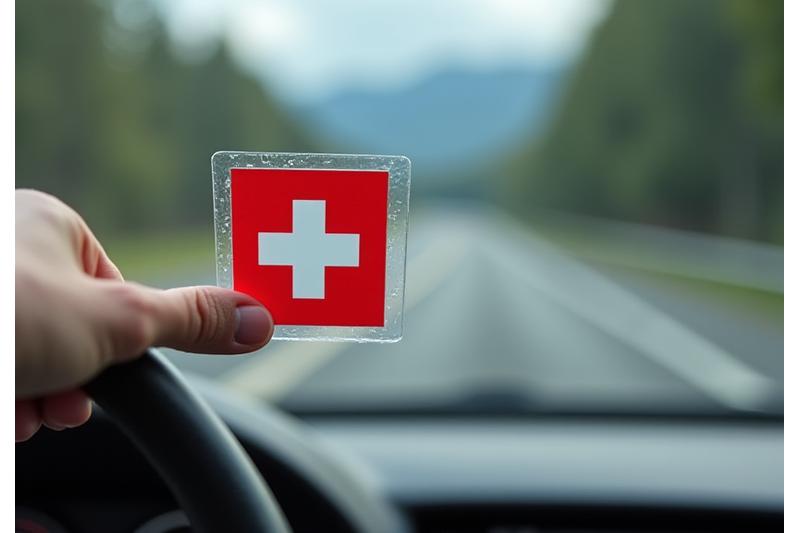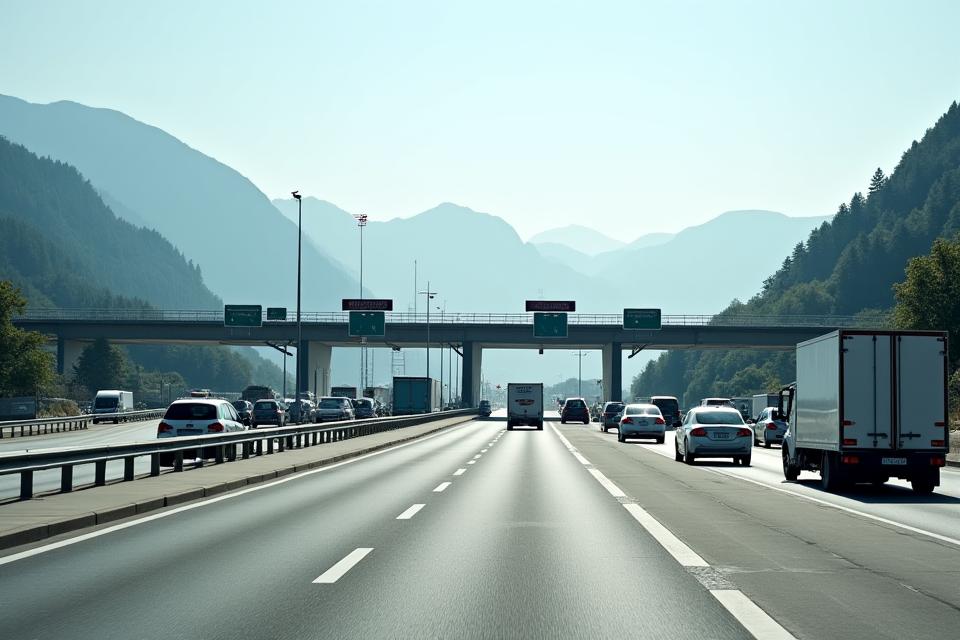The Complete Guide to the Swiss Vignette
Your essential resource for understanding and complying with Switzerland's motorway toll system.
What is a Vignette and Why is it Required?
The Swiss motorway vignette is an annual toll sticker or digital permit required for all vehicles (including motorcycles) weighing up to 3.5 tonnes using Switzerland's national motorways (Autobahnen und Autostrassen). It's a flat annual fee, not based on distance travelled. Its purpose is to finance the construction, maintenance, and operation of the national road network. Driving on vignette-mandatory roads without a valid, properly affixed physical vignette or registered digital vignette can result in significant fines.

Image: A typical Swiss motorway, requiring a valid vignette.
Where is the Vignette Mandatory?
The vignette is compulsory for all vehicles using designated national motorways and expressways, signposted in green. This includes the vast majority of major routes connecting Swiss cities and leading to border crossings. While local roads and cantonal roads typically do not require a vignette, it's crucial to understand that even short sections of motorway, such as those leading into or out of larger towns, fall under the vignette obligation.
There is no specific official map provided by the authorities detailing only vignette-mandatory roads, as nearly all primary inter-city connections are included. A good rule of thumb: if you see green road signs indicating motorways (A-roads or white on green for expressways), a vignette is required.
Physical Vignette: How to Affix it Correctly
The physical vignette is a sticker that must be correctly affixed to your vehicle. Incorrect placement or tampering can invalidate it and lead to fines. Here's a step-by-step guide:
- Clean the Surface: Ensure the inside of your windshield (or a fixed, non-removable part of a motorcycle) is clean and dry where the vignette will be placed.
- Windshield Placement (Cars/Vans):
- Behind the rearview mirror.
- On the left side of the windshield (driver's side in left-hand drive cars, passenger's side in right-hand drive cars).
Crucially: It must be placed where it is clearly visible from outside and does not obstruct the driver's view. Do NOT affix it with tape, foil, or any other removable method. Once removed, it is no longer valid.
- Motorcycles: Affix it to a non-removable, easily visible part of the motorcycle, such as the fuel tank or a fork leg.
- Removal: Vignettes are valid for a calendar year (e.g., 2024 vignette valid from December 1, 2023, to January 31, 2025). Once the new year's vignette is purchased, the old one should be removed.
 Proper placement ensures validity.
Proper placement ensures validity.
The New Digital Vignette (E-Vignette)
Since August 2023, Switzerland has introduced an optional digital vignette (E-Vignette). This offers greater flexibility, especially for those with changing number plates or multiple vehicles, as it is linked to the license plate, not the vehicle itself.
Benefits of the Digital Vignette:
- No physical sticker needed, simplifying application.
- Convenient online purchase from anywhere.
- Easier for vehicles with special windshields (e.g., heated).
- If you change your license plate (e.g., temporary plates, new car), you can transfer the vignette online (fees may apply).
How to Register & Purchase:
The official digital vignette can be purchased via the Federal Customs and Border Security (FOCBS) website. You will need to enter your vehicle's type, country of registration, and license plate number. Payment is made securely online. You will receive a confirmation, and your vignette is active immediately.
 Purchase your digital vignette online for convenience.
Purchase your digital vignette online for convenience.
Official Sales Points & Pricing
To ensure you purchase a genuine vignette, always buy from official and legal sources. Beware of unofficial online vendors charging inflated prices.
Where to Buy:
- Switzerland: At all border crossings, post offices (Die Post), gas stations (petrol stations) along motorways, and official toll booths.
- Abroad (Neighboring Countries): Often available at gas stations near the Swiss border in Germany, France, Austria, and Italy, as well as at automobile clubs (e.g., ADAC in Germany, ÖAMTC in Austria).
- Online (Digital Vignette): Exclusively via the official Federal Customs and Border Security (FOCBS) webshop.
Current Pricing (as of 2024):
The price of the Swiss vignette is currently CHF 40. This is a fixed annual price, regardless of when you purchase it during the year. There are no daily, weekly, or monthly vignettes.
 Official points of sale are often found at border crossings.
Official points of sale are often found at border crossings.
Common Questions About the Swiss Vignette
The physical vignette is NOT transferable. Once affixed, if you remove it or sell the car, it becomes invalid. The digital vignette, however, offers limited transferability: if you change your license plate number due to moving or getting a new car within the same canton, you can often request a transfer online via the official portal, sometimes for a small fee. It cannot be transferred to a different license plate number if you simply want to switch cars.
Driving on a vignette-mandatory road without a valid vignette can lead to a significant fine of CHF 200, plus the requirement to immediately purchase a valid vignette. Police conduct regular checks, often at motorway exits or border crossings.
Vehicles heavier than 3.5 tonnes do not use the vignette system; instead, they pay a Heavy Vehicle Charge (LSVA). Certain special tunnels (like the Grand Saint Bernard Tunnel or Munt la Schera Tunnel) are subject to separate tolls IN ADDITION to the vignette. These are clearly signposted before entry. Emergency vehicles and some agricultural vehicles are exempt.
No, the Swiss vignette is only available as an annual sticker or digital permit, valid from December 1st of the preceding year until January 31st of the following year (14 months total). There are no options for daily, weekly, or monthly vignettes.
This information is provided for guidance only. Always refer to official Swiss Federal Customs and Border Security (FOCBS) sources for the most current and authoritative regulations.
Visit Official FOCBS Website